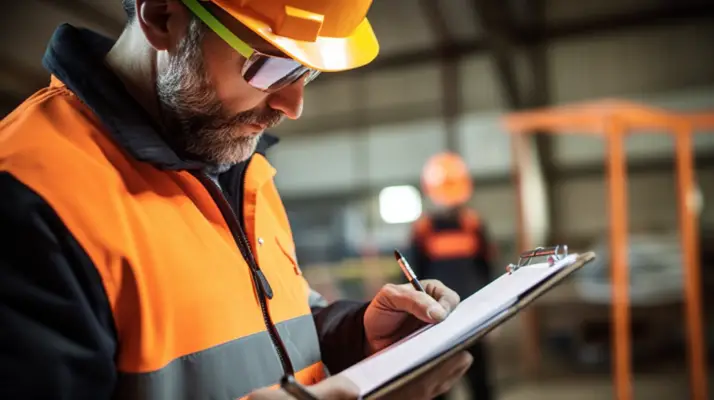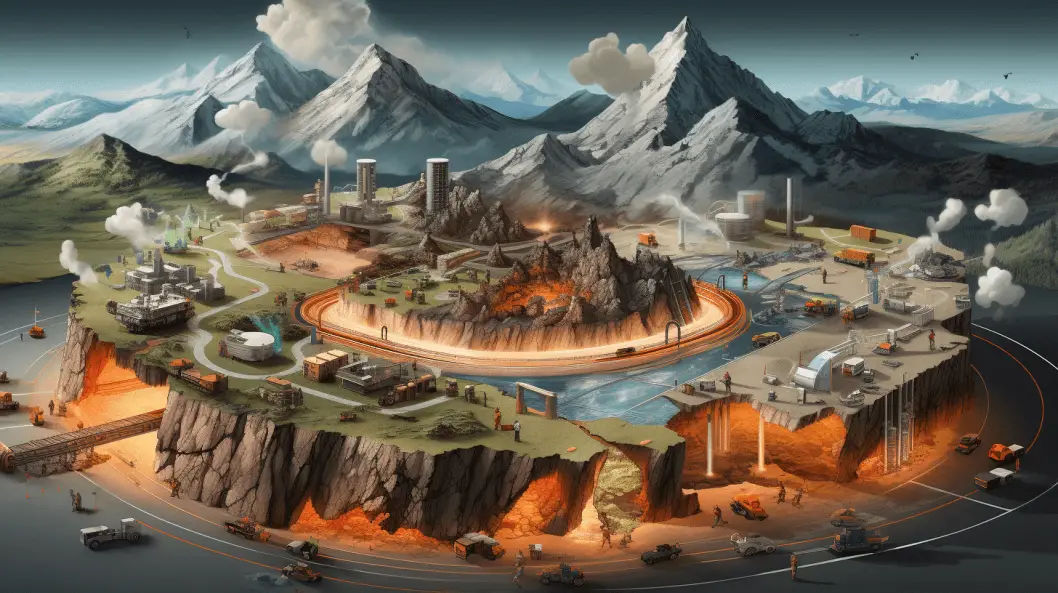Georisk-assessment and management of risk for engineered systems and geohazards is a critical area of study within the field of geotechnical engineering.
This interdisciplinary discipline focuses on analyzing and mitigating risks associated with geohazards, such as earthquakes, landslides, and floods, as well as the impact of these hazards on engineered systems.
The aim of georisk-assessment is to evaluate the potential consequences of geohazards on infrastructure and to develop strategies to minimize their impact.
This requires a thorough understanding of the geological and geophysical processes involved in these hazards and the vulnerabilities and resilience of engineered systems.
Using risk management techniques, georisk-assessment provides valuable insights for decision-makers in various sectors, including civil engineering, urban planning, and emergency management.
This article explores the definition of georisk-assessment and management, the analysis of risks associated with geohazards, and its application in the natural sciences.

Definition of Georisk-Assessment and Management of Risk for Engineered Systems
Georisk-assessment and management of risk for engineered systems is a process that aims to identify and mitigate potential hazards and risks associated with geohazards.
The purpose of georisk-assessment and management is to ensure the safety and reliability of engineered systems, such as infrastructure and buildings, in geologically active areas.
This involves evaluating the potential impact of geohazards, such as earthquakes, landslides, and volcanic eruptions, and implementing measures to minimize their effects on engineered systems.
Taylor & Francis, a prestigious academic publisher, takes pride in the green tick that signifies peer-reviewed content on their platform. Whether browsing articles on analysis for landslide risk, flood risk or investigating the intricacies of 3D embankment slope, you’ll find the green tick as a seal of credibility.
On the other hand, an orange padlock next to an article often indicates that the article’s publisher version requires a subscription or purchase.
Regarding the science behind soil spatial distribution, the research published by Taylor & Francis examines everything from homogeneous soil units to layered soil slopes. The impact of soil heterogeneity on factors such as erosion occurrences or bridge design specifications is often evaluated using analytical methods. DRASTIC, binary classification and conventional methods provide insights into the average soil degree and its role in engineering.
Article Full-text provides a more detailed exploration of topics, whether a study on aggregate piers or adaptive metamodels. You’ll find a wide range of article types on the Taylor & Francis platform, with the 10-fold cross-validation method often used in studies that involve binary classification or systematic method applications.
The Austrian Science Fund, recognized by the Austrian code, is a notable contributor to scientific research published in the journal. Its focus ranges from traditional approaches to cutting-edge technologies like the Geographical Information System. As a result, research on topics such as adaptive regression splines and random forest regression has become more accessible.
BGC Engineering Inc. is another noteworthy name frequently encountered in Engineering and Technology articles. The firm specializes in conducting accurate system reliability analyses, contributing significantly to understanding undesirable events like a 100-year flood event.
Lastly, the impact factor of an academic journal and the biological factors considered in various research studies further emphasize the high-quality, rigorous standards upheld by Taylor & Francis.
The journal website, accessible via the 1749-9526 Taylor & Francis portal, is a treasure trove of reliable, insightful, and cutting-edge research underpinned by an unwavering commitment to scientific integrity.
Purpose of Georisk-Assessment and Management
The purpose of georisk-assessment and management can be summarized as follows:
- Identification of potential risks and hazards.
- Quantitative analysis of the likelihood and consequences of these risks.
- Development of strategies and plans to mitigate and manage risks.
- Implementation of measures to reduce or eliminate risks.
- Continual monitoring and evaluation of risk reduction measures.
These activities involve various techniques and methodologies, including reliability analysis, numerical analysis, and engineering principles.
The ultimate goal is to enhance the resilience of engineered systems to geohazards and ensure the safety and well-being of society.
Analysis with Risk Management
This discussion on the subtopic of Analysis with Risk Management will explore key points such as:
- The probability of failure refers to the likelihood of an engineered system experiencing a negative event or outcome.
- Risk degree measures a risk event’s potential impact or severity.
- Scales of fluctuation: This involves examining a system’s various levels of risk and uncertainty.
- Quantified risk analysis: This involves using mathematical models and data to assess and quantify the level of risk associated with a particular system.
- Reliability analysis: This focuses on evaluating the reliability and performance of a system under different conditions and scenarios.
Probability of Failure
The probability of failure is crucial to consider when assessing and managing risk for engineered systems and geohazards. It plays a fundamental role in quantified risk analysis and analysis with risk management.
The probability of failure refers to the likelihood that a system or structure will not perform its intended function or meet its design criteria. It is determined by analyzing failure modes and considering material properties, environmental conditions, and operational loads.
In geotechnical design, the probability of failure is often evaluated using the first-order reliability method and fault tree analysis. These techniques allow for a comprehensive analysis of landslide risk, flood risk, and other geohazards.
Quantifying the probability of failure, engineers and risk managers can make informed decisions and implement appropriate mitigation measures to ensure the safety and reliability of engineered systems.
Degree of Risk
The degree of risk is determined by considering various factors such as failure modes, material properties, environmental conditions, and operational loads. A quantitative risk assessment is essential in managing risk for engineered systems and geohazards.
This involves utilizing reliability-based design and probabilistic approaches to estimate the probability of failure and quantify the associated risks. Erosion prediction models and geotechnical systems play a crucial role in assessing the degree of risk for geohazards.
System reliability analyses, specifically in rock engineering, further contribute to understanding the potential risks and mitigating measures required.
Incorporating these approaches and methodologies, risk assessment can provide valuable insights into the degree of risk associated with engineered systems and geohazards, enabling informed decision-making and effective risk management strategies.
Scales of Fluctuation
Scales of fluctuation provide a framework for understanding and characterizing the variations and patterns in natural phenomena, such as erosion rates, material properties, and environmental conditions, which are crucial in assessing the potential risks and uncertainties associated with geotechnical and geohazard events.
To better understand the concept of scales of fluctuation in georisk assessment and management, it is important to consider the following:
- Spatial scales: This refers to the range of sizes over which fluctuations occur. It helps determine the spatial extent of potential risks and allows for identifying hotspots or areas of high vulnerability.
- Temporal scales: This pertains to the time intervals over which fluctuations occur. It aids in understanding the frequency and duration of events, enabling the development of appropriate risk management strategies.
- Magnitude scales: This relates to the magnitude or intensity of fluctuations. It helps quantify the risk associated with a particular event or phenomenon, allowing for the implementation of reliability-based design approaches.
Understanding the fluctuation scales, georisk assessment, and management can be more precise and effective in mitigating the potential risks and uncertainties associated with engineered systems and geohazards.
Quantified Risk Analysis
Quantified Risk Analysis (QRA) is a crucial tool in the georisk-assessment and management of risk for engineered systems and geohazards. It allows for a detailed examination of potential risks associated with these systems and hazards, providing a comprehensive understanding of their likelihood and potential consequences.
QRA involves using quantitative methods to estimate the probability of occurrence and impact of various hazards on engineered systems, such as earthquakes, landslides, or floods. By integrating data from historical events, numerical models, and expert judgment, QRA enables decision-makers to make informed choices regarding risk mitigation and resource allocation.
To further illustrate the importance of QRA, a 3-column and 4-row table is presented below, highlighting its key features and benefits.
| Key Features | Benefits | Applications |
| Quantitative | Improved decision-making | Engineering design |
| Data-driven | Enhanced risk communication | Land-use planning |
| Probabilistic | Efficient resource allocation | Emergency management |
| Integrative | Cost-effective risk mitigation | Infrastructure development |
Reliability Analysis
Reliability analysis is an important aspect of evaluating the reliability of various systems and hazards. This analysis involves assessing the probability of failure or success of a system or hazard under different conditions.
In georisk assessment and management, reliability analysis plays a crucial role in ensuring engineered systems’ safety and efficiency and understanding and mitigating geohazards.
Key aspects of reliability analysis in this context include:
- Reliability-based design optimization: This approach involves optimizing the design of a system or hazard based on its reliability, ensuring that it can withstand extreme events and undesirable outcomes.
- Representative design: Reliability analysis helps in determining the representative design parameters for different systems and hazards, considering factors such as material properties, loading conditions, and environmental influences.
- Analysis in rock engineering: Reliability analysis is particularly important in assessing rockfall hazards, where the combination of hazards, such as slope instability and extreme weather events, can pose a major risk. By quantifying the reliability of rock engineering designs, engineers can better assess the potential for rockfall events and implement appropriate mitigation measures.
Logistic Regression Models
Logistic regression models are statistical tools used to analyze categorical data and predict the probability of an event occurring based on a set of independent variables.
In georisk-assessment and management of risk for engineered systems and geohazards, logistic regression models can be employed to assess and manage various types of risks.
By examining the relationship between the independent variables and the categorical outcome variable, these models can provide insights into the factors contributing to georisk events.
This information can then be used to develop strategies and interventions to mitigate risks associated with engineered systems and geohazards.
Logistic regression models play a crucial role in risk assessment and management by enabling decision-makers to make informed choices based on empirical evidence and statistical analyses.
Remote Sensing Technologies
Remote sensing technologies provide valuable information through satellite or airborne sensors, allowing for the collection and analysis of georisk-assessment data and risk management for engineered systems and geohazards.
These technologies have revolutionized how we monitor and assess risks in various fields, including environmental management, disaster response, and infrastructure development.
Capturing high-resolution images and data from remote locations, remote sensing technologies enable us to identify potential geohazards and assess their impact on engineered systems. This discusses the relevance of remote sensing technologies in risk assessment and management.
A 2-column and 4-row table can be incorporated to grab the audience’s attention, highlighting the key features and advantages of remote sensing technologies. This table could include columns such as “Technology”, “Applications”, “Advantages”, and “Limitations”, and rows describing various remote sensing technologies such as LiDAR
Synthetic Aperture Radar (SAR) and Hyperspectral Imaging. This detail-oriented and technical approach will provide readers with a comprehensive understanding of how remote sensing technologies contribute to risk management in engineered systems and geohazards.
Natural Hazards and Their Impact on Georisk-Analysis
This focuses on the impact of natural hazards on georisk-analysis. Specifically, it examines the effects of internal erosion, excessive deformation, and resistance against overtopping.
Internal erosion refers to the gradual erosion of soil particles within a geotechnical structure. This erosion leads to losing strength and stability, compromising the structure’s integrity.
Excessive deformation, on the other hand, involves the displacement or distortion of the engineered system. This deformation occurs due to external forces, such as earthquakes or landslides. These forces can cause significant damage and compromise the performance of the structure.
Resistance against overtopping is another important factor to consider in georisk-analysis. It refers to the ability of a structure to withstand the flow of water over its crest without being breached or damaged. A structure with poor resistance against overtopping is more susceptible to flooding and water damage.
These factors are crucial to consider in georisk-analysis as they can greatly affect the overall stability and performance of engineered systems in the face of natural hazards. It is essential to assess and mitigate these risks to ensure the safety and longevity of geotechnical structures.

Internal Erosion
Internal erosion, a significant geohazard in engineering systems, occurs when water flows through soil or other porous materials, leading to the removal of particles and the potential for structural failure.
It is crucial to assess and manage the risk of internal erosion to ensure the stability and longevity of engineered systems.
To better understand internal erosion, consider the following:
- Mechanisms: Internal erosion can occur through various mechanisms, including suffusion, piping, and concentrated leak erosion.
- Factors: Several factors influence the susceptibility of soils to internal erosion, such as particle size distribution, soil structure, hydraulic gradients, and flow velocities.
- Indicators: Identifying potential signs of internal erosion, such as sinkholes, seepage, or changes in water quality, is essential for early detection and mitigation.
- Mitigation Measures: Effective management of internal erosion involves implementing measures like filters, erosion-resistant materials, and proper drainage systems to control water flow and prevent erosion.
Incorporating georisk assessment and management techniques, engineers can mitigate the geohazard of internal erosion and ensure the safety and reliability of engineered systems.
Excessive Deformation
Excessive deformation poses a significant challenge in engineering projects. It can lead to structural instability and compromise the system’s overall performance. When assessing georisk, it is crucial to consider the potential for excessive deformation and develop management strategies to mitigate its effects.
Excessive deformation can occur due to various factors. These factors include inadequate soil properties, poor design, or unexpected geohazards. Understanding the resistance against overtopping and erosion is essential in evaluating the risk associated with excessive deformation.
Additionally, slope stability analysis is vital in assessing the potential for excessive deformation. Monitoring techniques, such as ground-based surveys and remote sensing technologies, can provide valuable data for managing and mitigating the risk of excessive deformation.
Incorporating these considerations into georisk assessment and management, engineered systems can be better designed and implemented to withstand potential excessive deformation threats.
Resistance Against Overtopping
Resistance against overtopping is a critical factor to consider in engineering projects, as it determines the system’s ability to withstand powerful forces and protect against potential devastation.
In the context of georisk-assessment and management of risk for engineered systems and geohazards, overtopping refers to the scenario where water exceeds the design level of a structure, such as a dam or a coastal defense system.
The resistance against overtopping is typically evaluated through detailed hydraulic analyses, which consider wave action, water levels, and structure geometry.
Various measures can be implemented to enhance the system’s ability to resist overtopping, such as using revetments, breakwaters, or increased crest heights.
It is crucial to carefully assess and manage the risk associated with overtopping to ensure the safety and reliability of engineered systems, particularly in areas prone to geohazards.
Application in Natural Sciences
Although georisk assessment and management often focus on engineered systems and geohazards, its application in natural sciences plays a crucial role in understanding and mitigating potential risks associated with natural phenomena.
In natural sciences, georisk assessment involves evaluating the potential for earthquakes, landslides, and tsunamis to cause failures in natural systems. This assessment helps develop codes and standards that ensure the safety and resilience of communities and infrastructures.
Furthermore, georisk management in natural sciences involves assessing the factors that contribute to the likelihood and consequences of these events. By identifying and addressing these factors, georisk management helps minimize the potential loss of life and property damage caused by natural hazards.
Applying georisk assessment and management in natural sciences is essential for understanding and mitigating risks associated with natural events.
- It provides a comprehensive understanding of the potential risks associated with natural phenomena.
- It helps develop codes and standards for ensuring the safety and resilience of communities and infrastructures.
- It enables identifying and assessing factors that contribute to the likelihood and consequences of natural events.
- It plays a crucial role in minimizing the potential loss of life and property damage caused by natural hazards.
Frequently Asked Questions
What are the different types of geohazards that can affect engineered systems?
Some geohazards that can affect engineered systems include earthquakes, landslides, volcanic eruptions, floods, tsunamis, and sinkholes. These natural events can cause damage to infrastructure and pose risks to human safety.
What are the key steps involved in conducting a georisk-assessment for engineered systems?
The key steps in conducting a georisk-assessment for engineered systems include identifying potential geohazards, assessing their likelihood and magnitude, evaluating the system’s vulnerability, analyzing the potential consequences, and developing mitigation strategies.
How does risk management play a role in minimizing georisk for engineered systems?
Risk management plays a crucial role in minimizing georisk for engineered systems. It involves identifying, assessing, and prioritizing risks, developing mitigation strategies, implementing controls, monitoring their effectiveness, and continuously improving the risk management process.
What are some common challenges faced in applying georisk-assessment in natural sciences?
Common challenges in applying georisk-assessment in natural sciences include uncertainty in data and models, limited understanding of complex geohazards, difficulties in quantifying and assessing risks, and the need for interdisciplinary collaboration and expertise.
Can georisk-assessment techniques be applied to non-engineered systems as well?
Georisk-assessment techniques can be applied to non-engineered systems as well. These techniques provide a systematic approach to evaluating and managing risks associated with various hazards, ensuring effective risk mitigation and resilience in engineered and natural systems.

Conclusion
Georisk-assessment and management of risk for engineered systems and geohazards is a crucial field that analyzes and mitigates potential risks associated with natural hazards.
By using risk management techniques, the impacts of natural hazards on engineered systems can be evaluated and appropriate measures can be taken to minimize potential damages.
This approach finds wide application in various natural sciences, helping better understand geohazards and their environmental effects.
Georisk-assessment and management play a vital role in ensuring the safety and sustainability of engineered systems in the face of natural hazards.

Chris Ekai is a Risk Management expert with over 10 years of experience in the field. He has a Master’s(MSc) degree in Risk Management from University of Portsmouth and is a CPA and Finance professional. He currently works as a Content Manager at Risk Publishing, writing about Enterprise Risk Management, Business Continuity Management and Project Management.

